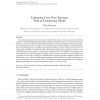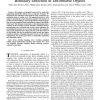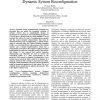627 search results - page 93 / 126 » Evolution and learning in multiagent systems |
COGSCI
2007
13 years 7 months ago
2007
An expression-induction model was used to simulate the evolution of basic color terms to test Berlin and Kay’s (1969) hypothesis that the typological patterns observed in basic ...
INFOCOM
2008
IEEE
14 years 2 months ago
2008
IEEE
—Knowledge of the network path properties such as latency, hop count, loss and bandwidth is key to the performance of overlay networks, grids and p2p applications. Network operat...
TIP
2008
13 years 7 months ago
2008
We propose a principled framework for recursively segmenting deformable objects across a sequence of frames. We demonstrate the usefulness of this method on left ventricular segmen...
CAISE
2011
Springer
12 years 11 months ago
2011
Springer
Abstract. Flexibility and automatic learning are key aspects to support users in dynamic business environments such as value chains across SMEs or when organizing a large event. Pr...
JSW
2008
13 years 7 months ago
2008
Dynamic system reconfiguration techniques are presented that can enable the systematic evolution of software systems due to unanticipated changes in specification or requirements. ...



